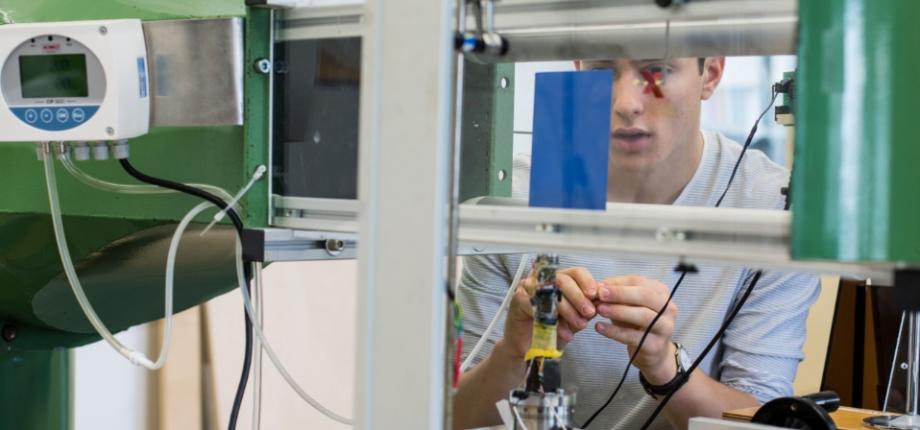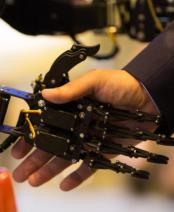Master Year 2 Fluid Mechanics

| Year | Master Year 2 |
| Program | Fluid Mechanics |
| ECTS Credits | 60 |
| Language | English |
| Orientation | Research, Industrial R&D |
| Location | Palaiseau Campus, Sorbonne Université |
| Course duration | 12 months, full time |
| Course start | September |
| Degree awarded | Master’s degree |
WHY ENROLL IN THIS PROGRAM?
Asset n° 1
Deepen your knowledge with lectures and supervision from expert professors and researchers
Asset n°2
Develop excellent technical and scientific skills in fluid mechanics through a broad range of courses
Asset n°3
Benefit from a research-focused program research with close links to the Institut Polytechnique de Paris laboratories
This Fluid Mechanics Year 2 Master’s program offers an overall teaching experience covering the main active research domains in fluid mechanics. The first semester is dedicated to lectures in fundamental and theoretical fluid mechanics as well as numerical and experimental aspects, plus, possibly, a short research project. The second part of the year consists in an internship either in academic or industrial laboratories.
Objectives
This program enables students to:
- Gain expertise in fundamental and theoretical fluid mechanics covering numerical and experimental aspects during the first part of the year
- Conduct research during an internship in an academic or industrial laboratory during the second semester
This program opens up a wide range of career opportunities. Most students pursue a PhD in an academic or industrial laboratory, while others directly join the research and development team of a private company.
Semester 1
3 ECTS per lectures, 10 lectures to choose among the following list with the possibility to exchange few lectures with other lectures from the master. Written or project exams.
This course aims to provide an overview of state of the art experimental methods in fluid mechanics as well as the basics of signal processing to analyse experimental or numerical data.
The course is divided into two parts:
- 4 lectures in classroom will introduce the students to experimental methods (Hot-wire anemometry, Laser Doppler Anemometry, Particle Image Velocimetry, Particle Tracking) and signal processing methods (spectral and statistical analysis, various modal decompositions…)
- 3 practical sessions in the laboratory where the students, by group of two, will tackle a scientific problem using one of the experimental techniques introduced during the lecture
Evaluation is based on a oral defense and on the evaluation of the work provided during the lab sessions.
Prerequisite: Master 1 level in physics or mechanics is sufficient.
Timing: The Course is offered in the first part (sept-nov) of the M2 year
Credits: 3 ECTS
Hours: 30 hours
This course aims to provide the basics of numerical multiphase fluid mechanics and to offer a first approach to numerical simulation methods.
Topics covered include: Navier Stokes equations, geometric representation of fluid interfaces, jump relations on fluid interfaces, one-fluid formulation. Finite difference methods for the Navier-Stokes equation, projection method, Poisson equation, relaxation method, boundary conditions, exit conditions, methods for multiphase flow such as the volume of fluid method. Numerical methods for surface tension.
The participants are carrying out a project based on the free open source software platform Basilisk making it possible to produce the flows numerically, including, in particular, the Bénard Von Karman vortex street, droplet fall, vortex pairs, nucleate boiling, Lagrangian mixing, atomization and granular materials.
Prerequisite: Overall, a basic Master 1 level in applied maths, physics or mechanics is required, and some knowledge of the linux operating system.
Bibliography:
- Tryggvason G., Scardovelli R. and Zaleski S. 2011: Direct Numerical Simulations of Gas-Liquid Multiphase Flows, Cambridge University Press.
- Basilisk: http://basilisk.fr
Timing: The Course offered in the first part (sept-nov) of the M2 year
Credits: 3 ECTS
Hours: 30 hours.
This course aims to provide the basics of asymptotic methods: Matched Asymptotic Expansion, Multiple Scale Methods, WKB method, Homogenization, Boundary Layers…
We focus on the influence of a parameter, say epsilon, on the behavior of a differential equation when the parameter is smaller and smaller.
Methods are applied first on simple oscillators (mass/spring). Then we present examples of influence of small parameters in fluid mechanics. For example we look at the behavior of the Navier Stokes equations at small Reynolds (Stokes and Oseen), at small inverse of Reynolds number (Boundary Layer, separation: Triple Deck) or small depth (Shallow Water, KDV equation, nodular bores…)…
Prerequisite: Overall, a basic Master 1 level in applied maths, physics or mechanics is required.
Bibliography:
- Fluid Dynamics, Part 2 Asymptotic Problems of Fluid Dynamics Anatoly I. Ruban (2015).
- Perturbation methods J. Hinch Cambridge University Press, (1991).
Timing: The Course offered in the first part (sept-nov) of the M2 year.
Credits: 3 ECTS
Hours: 30 hours.
Information will be available soon.
The course introduces the fundamental concepts and techniques of instability theory in the context of fluid mechanics. Several common types of flow instability and the underlying physical mechanisms are discussed. Linear stability analysis is performed by use of the method of normal modes. Local instability properties (temporal, spatial and spatio-temporal growth in parallel base flows) are discussed for the example of a free shear layer; the concepts of transient growth and optimal perturbation are introduced and tested for plane Poiseuille flow. The stability of nonparallel steady flow, like the cylinder wake, is characterised in terms of global eigenmode analysis.
During exercise sessions, which are integrated within the four-hour teaching blocks, students will use basic python (numpy) and the FEniCS library on their own computers to gain numerical hands-on experience with the theoretical concepts developed in the lectures. The evaluation is based on a final group project, extending over several weeks.
Prerequisite: Master 1 level with good knowledge of fluid mechanics and basic linear algebra (matrix operations, eigenvalue problems). Advanced programming abilities are not required, but it will necessary to acquire some command of numpy during the course.
Bibliography:
F. Charru: "Hydrodynamic Instabilities", Cambridge University Press, 2011. (Suggested reading, not required.)
Timing: The course is offered in the first part (September-November) of the M2 year
Credits: 3 ECTS
Hours: 28 hours + project presentation
The course presents the fundamental properties of Stokes flow, when inertia plays a negligeable role with respect to viscous dissipation. This class of flows can be found in many applications including biology (swimming bacteria), biomedical (blood flows), environmental flows (motion of glaciers on centennial scales) and industry (glass or cheese manufacturing). The goal of this class is to present the specific methods developed to study this type of flows.
During the class, fundamental concepts and recent research developments in that domain will be presented through formal lectures and presentation/discussion of recent research papers by the students.
Covered topics include:
- Fundamental equations and theorems.
- Singular representations.
- Confined flows.
- Thin films.
- Motion of particles in Stokes flow (individual and collective)
- Swimming in low Reynolds number flows
- Suspensions
Prerequisite: Incompressible fluid mechanics (viscous and inertial)
Bibliography:
- “Microhydrodynamics, Brownian Motion and Complex fluids”, by M. Graham, 2019, Cambridge University Press.
- “A physical introduction to suspension dynamics”, by J. F. Morris & E. Guazzelli, 2012, Cambridge University Press.
- “Advanced Transport Phenomena”, by L. G. Leal, 2007, Cambridge University Press.
Timing: The Course is offered in the second semester (Dec-Feb) of the M2 year
Credits: 3 ECTS
Hours: 32 hours
The dynamics of planets, stars and galaxies is deeply linked to nonlinear physics. The considerable progress of this discipline in the last decades has dramatically changed our understanding of many natural phenomena. This is partly due to the ubiquity of fluid flows in the atmospheres and interiors of planets and stars. It is now clear that geophysical and astrophysical fluid dynamics (GAFD) differs from traditional fluid mechanics in that it deals with turbulent, sometimes electrically conducting, and most often rapidly rotating and highly stratified flows. These properties lead to a multitude of nonlinear behaviors, and constitute the core of this course.
We list the different topics that will be presented
Chapter 1 : Rotating flows. Coriolis force – geostrophic balance – Proudman-Taylor theorem.
Chapter 2 : Electrically conducting fluids. Magnetohydrodynamics – dynamo instability -alpha and omega effects – chaotic field reversals
Chapter 3 : Thermal convection. Rayleigh-Benard instability – pattern formation -Secondary instabilities.
Chapter 4 : Stably-stratified flows. Internal gravity waves, double-diffusion, baroclinicity
Chapter 5 : Astrophysical turbulence. Angular momentum transport – accretion disks – rotation of radiative stars – Tayler-Spruit dynamo.
Prerequisites :
- Basic hydrodynamics (Eulerian or Lagrangian description, Navier-Stokes equation) ;
- No prerequisite is expected for what concerns electromagnetism.
Bibliography :
- H.K. Moffatt, Magnetic Field Generation in Electrically Conducting Fluids, Cambridge University Press.
- S. Chandraskhar, Hydrodynamic and Hydromagnetic Stability 1961, Clarendon Press, Oxford; reprinted by Dover Publications, Inc., 1981.
Credits: 3 ECTS
Hours: 32 hours
Turbulence is a fundamental phenomenon at the crossroads of out-of-equilibrium physics, engineering, and mathematics, with applications ranging from aeronautics to climate dynamics. Despite the ubiquity of turbulent flows in everyday life, proving the existence of solutions to the Navier-Stokes equations remains one of the Millennium Prize Problems identified by the Clay Mathematics Institute. Meanwhile, physicists and engineers have developed powerful theoretical tools to predict and characterize the statistics of turbulent flows, supported by advancing numerical and experimental methods. The first part of the course will emphasize these modern developments, while the second part of the course will be focused on applying these methods to various forms of turbulence encountered in the climate system.
I. Homogeneous isotropic turbulence: Richardson energy cascade, spectral description, Kolmogorov theory.
II. Chaotic dynamics: sensitivity to initial conditions, Lyapunov exponents. Loss of predictability and application to weather forecasting.
III. Wall bounded turbulence and turbulent boundary layers: law of the wall, wall shear stress.
IV. Turbulent convection with and without rotation.
V. Two-dimensional turbulence and the formation of large-scale structures.
VI. Ocean two-dimensional turbulence above topography: statistical mechanics.
VII. Turbulent transport in oceans and planetary atmospheres: effective transport and multiscale description.
Prerequisites:
- Basic hydrodynamics (Eulerian or Lagrangian description, Navier-Stokes equation) ;
- No prerequisites are expected for climate dynamics.
Bibliography:
- U. Frisch, Turbulence: the legacy of A.N. Kolmogorov, Cambridge University Press.
- S.B. Pope, Turbulent flows, Cambridge University Press.
- R. Salmon, Lectures on Geophysical Fluid Dynamics, Oxford University Press.
Schedule: December to February
Credits: 3 ECTS
Hours: 32 hours
In this course, we discuss classical phenomena and recent developments in the physics of fluid interfaces – considering surface tension effects and the resulting hydrodynamics in problems such as wetting and non-wetting, impregnation, coating, drop manipulation, Marangoni effect, flows in confined and complex geometries. The course is illustrated by movies and experiments, and it does not assume any prior knowledge in the field. The fundamental principles are applied in natural situations and in technological applications developed mainly in the field of droplet-based microfluidics.
Prerequisite: Overall, a basic Master 1 level in applied maths, physics or mechanics is required.
Bibliography:
de Gennes, P. G., Brochard-Wyart, F., & Quéré, D. (2004). Capillarity and wetting phenomena: drops, bubbles, pearls, waves,. Springer New York.
Timing: The Course offered in the first part (sept-nov) of the M2 year
Credits: 3 ECTS
Hours: 30 hours
The objective of the course is to introduce and adapt reduced-order-modelling and modern control techniques in order to stabilize flow instabilities and therefore delay transition to turbulence. These issues play a crucial role in both aeronautical and mechanical engineering applications.
Topics covered include:
- Amplitude equations and open-loop control: multiple time-scale analysis, compatibility condition, bifurcation analysis in real systems.
- Model reduction with balanced truncation and closed-loop control: input/output dynamics, observability and controllability Gramians, Hankel singular-values, balanced basis.
- Proper Orthogonal Decomposition and Galerkin projection of Navier-Stokes equations
- Koopman-based reduced order modelling of nonlinear dynamics
All concepts will be illustrated on cylinder and open-cavity flows with codes based on the free open source software platform FreeFem++ and python.
For the evaluation, the participants are given articles that propose new techniques and algorithms and build on the provided FreeFem++/python codes to implement and illustrate the new techniques.
Prerequisite: Fundamental notions of fluid mechanics, hydrodynamic instabilities, skills in applied math (linear algebra, Taylor expansions, series, integration by parts, …) and scientific computing (python programming).
Bibliography:
- D. Sipp. Open-loop control of cavity oscillations with harmonic forcings, J. Fluid Mech., 708, 439-468, 2012.
- D. Sipp and P.J. Schmid. Linear Closed-Loop Control of Fluid Instabilities and Noise-Induced Perturbations: A Review of Approaches and Tools. Appl. Mech. Rev., 68(2), 020801, 2016.
- Ma, Z., Ahuja, S., & Rowley, C. W. (2011). Reduced-order models for control of fluids using the eigensystem realization algorithm. Theoretical and Computational Fluid Dynamics, 25, 233-247.
- Schmid, P. J. (2022). Dynamic mode decomposition and its variants. Annual Review of Fluid Mechanics, 54, 225-254.
Timing: The Course is offered in the second part (December-February) of the M2 year
Credits: 3 ECTS
Hours: 36 hours
This course aims to provide simple methods to handle so-called complex phenomena described by nonlinear partial differential equations. Systems governed by nonlinear equations display multiple solutions with different symmetries. We study the bifurcations i.e. the transitions between these solutions when a parameter of the system is varied. We show that in the vicinity of these bifurcations, the system is governed by universal equations, normal forms, that mostly depend on the broken symmetries at the transition. We emphasize the analogy with phase transitions, but also point out differences such that limit cycles or chaotic behaviors that do not occur at equilibrium.
The following problems are considered:
1. Nonlinear waves in dispersive media: a universal equation that describes the motion of a wave packet, the nonlinear Schrödinger equation. Instability of a quasi-monochromatic wave, generation of solitons. Solitons as particles.
2. Pattern-forming instabilities in hydrodynamics. Amplitude equations from symmetry arguments.
3. Analogy with the mean field description of phase transitions: superfluidity, superconductivity, magnetic domains, commensurable-incommensurable transitions.
4. Broken symmetries and neutral modes. Secondary instabilities described by phase dynamics. Topological defects.
5. Subcritical bifurcations and metastable states. Localized structures. Analogy with the liquid-vapor transition. Nucleation and Maxwell construction. Non potential effects.
Prerequisite: Overall, a basic Master 1 level in applied maths, physics or mechanics is required.
Bibliography:
- G. B. Witham, Linear and nonlinear waves, Wiley (New York, 1974).
- A. C. Newell, Solitons in mathematics and physics, SIAM (1985).
- Hydrodynamics and nonlinear instabilities, edited by C. Godrèche and P. Manneville, Cambridge University Press (1998).
Timing: The Course is offered in the second part (december-february) of the M2 year
Credits: 3 ECTS
Hours: 30 hours
This teaching aims to form students to aerodynamics. Aerodynamics aims to predict the influence of air flows and object shapes on mechanical stresses and heat transfers in applications ranging from airplanes, to land vehicles and to buildings. It is an extremely rich and lively subject in terms of basic and applied research that we approach through a series of 4 lectures and exercise sessions. Students will learn the fundamental laws of incompressible aerodynamics, by sequentially addressing aerodynamic forces, the origin of lift and drag, and finally by establishing the physical models and the mathematical framework that allow to deal with all the problems of interest. The course goes deep into the concepts that may have been covered before, especially in M1. Emphasis is placed on the phenomenology of flows, using numerous illustrations. The lessons are followed by deepening sessions with exercises which aim to provide tools to calculate aerodynamic forces and properties of flows over a set of concrete applications. A final session is devoted to carrying out numerical simulations of the flow around a wing profile, with application to a configuration of tandem and ground effect wings.
Prerequisite: Overall, a basic Master 1 level in applied maths and fluid mechanics is required.
Bibliography:
- A. Giovannini, C. Airiau, Aérodynamique Fondamentale, Cepadues Editions.
- J. Anderson, Fundamental of Aerodynamics, Mc Graw Hill.
Timing: The Course offered in the second part (nov-feb) of the M2 year
Credits: 1.5 ECTS
Hours: 16 hours
The aim of this course is to introduce different optimisation algorithms that can be used to optimise any partial differential equation. No particular application is targeted. Instead, the steps of each algorithm will be discussed for the optimisation of generic functions. Nevertheless, the methods presented in this course are state of the art in many aeronautical and mechanical engineering applications.
The following topics are covered:
- An introduction of the lingo and the terminology used in the community: how to formalise an optimisation problem and how to extract exact and approximate gradients of the underlying PDE.
- Descent-based optimisation algorithm: 1st order algorithms, line-search algorithms and second order methods.
- Constrained optimisation: introductions of the Lagrangian and the Lagrange multiplier (adjoint equations)
- Derivative-free methods: Population and stochastic methods.
- Strategies for reducing the cost of function evaluations, with application to stochastic-based methods.
The participants are meant to implement and compare different algorithms using python codes and notebooks.
Prerequisite: Skills in applied math (linear algebra, taylor-expansions, series, integration by parts, …) and scientific computing (python programming).
Bibliography:
- M.J. Kochenderfer & T.A. Wheeler. Algorithms for optimisation. The MIT Press. 2019.
- M.D. Gunzburger. Perspectives in flow control and optimisation. SIAM 2003.
Timing: The Course is offered in the first part of the M2 year
Credits: 1.5 ECTS
Hours: 18 hours
For this course, you have to find a researcher working in a laboratory involved in the Fluid Mechanics master and define with him/her a research project (experimental, numerical or theoretical) that you will conduct under his/her supervision for at least 10 days along a period of time of 8 to 12 weeks.
Timing: the project better takes place in the second part of the M2 year.
Credits: 3 ECTS
Hours: at least 40 hours
Semester 2
Internship
Admission requirements
Academic prerequisites
Completion of the first year of Master in biomechanic tracks (mechanics, physics or applied mathematics) at Institut Polytechnique de Paris or equivalent in France or abroad
Language prerequisites
English and/or basic French
Lectures are given in English, even if a few elective courses are offered in French. An English-speaking student can graduate without any French prerequisites. French lectures for non-French speaking student are also offered along the program.
How to apply
Applications can be submitted exclusively online. You will need to provide the following documents:
- Transcript
- Two academic references (added online directly by your referees)
- CV/resume
- Statement of purpose
You will receive an answer in your candidate space within 2 months of the closing date for the application session.
Fees and scholarships
Registration fees are available here
Find out more about scholarships
Please note that fees and scholarships may change for the following year.
Applications and admission dates
Coordinators
Program office
General enquiries
This Fluid Mechanics Year 2 Master’s program offers an overall teaching experience covering the main active research domains in fluid mechanics. The first semester is dedicated to lectures in fundamental and theoretical fluid mechanics as well as numerical and experimental aspects, plus, possibly, a short research project. The second part of the year consists in an internship either in academic or industrial laboratories.
Objectives
This program enables students to:
- Gain expertise in fundamental and theoretical fluid mechanics covering numerical and experimental aspects during the first part of the year
- Conduct research during an internship in an academic or industrial laboratory during the second semester
This program opens up a wide range of career opportunities. Most students pursue a PhD in an academic or industrial laboratory, while others directly join the research and development team of a private company.
Semester 1
3 ECTS per lectures, 10 lectures to choose among the following list with the possibility to exchange few lectures with other lectures from the master. Written or project exams.
This course aims to provide an overview of state of the art experimental methods in fluid mechanics as well as the basics of signal processing to analyse experimental or numerical data.
The course is divided into two parts:
- 4 lectures in classroom will introduce the students to experimental methods (Hot-wire anemometry, Laser Doppler Anemometry, Particle Image Velocimetry, Particle Tracking) and signal processing methods (spectral and statistical analysis, various modal decompositions…)
- 3 practical sessions in the laboratory where the students, by group of two, will tackle a scientific problem using one of the experimental techniques introduced during the lecture
Evaluation is based on a oral defense and on the evaluation of the work provided during the lab sessions.
Prerequisite: Master 1 level in physics or mechanics is sufficient.
Timing: The Course is offered in the first part (sept-nov) of the M2 year
Credits: 3 ECTS
Hours: 30 hours
This course aims to provide the basics of numerical multiphase fluid mechanics and to offer a first approach to numerical simulation methods.
Topics covered include: Navier Stokes equations, geometric representation of fluid interfaces, jump relations on fluid interfaces, one-fluid formulation. Finite difference methods for the Navier-Stokes equation, projection method, Poisson equation, relaxation method, boundary conditions, exit conditions, methods for multiphase flow such as the volume of fluid method. Numerical methods for surface tension.
The participants are carrying out a project based on the free open source software platform Basilisk making it possible to produce the flows numerically, including, in particular, the Bénard Von Karman vortex street, droplet fall, vortex pairs, nucleate boiling, Lagrangian mixing, atomization and granular materials.
Prerequisite: Overall, a basic Master 1 level in applied maths, physics or mechanics is required, and some knowledge of the linux operating system.
Bibliography:
- Tryggvason G., Scardovelli R. and Zaleski S. 2011: Direct Numerical Simulations of Gas-Liquid Multiphase Flows, Cambridge University Press.
- Basilisk: http://basilisk.fr
Timing: The Course offered in the first part (sept-nov) of the M2 year
Credits: 3 ECTS
Hours: 30 hours.
This course aims to provide the basics of asymptotic methods: Matched Asymptotic Expansion, Multiple Scale Methods, WKB method, Homogenization, Boundary Layers…
We focus on the influence of a parameter, say epsilon, on the behavior of a differential equation when the parameter is smaller and smaller.
Methods are applied first on simple oscillators (mass/spring). Then we present examples of influence of small parameters in fluid mechanics. For example we look at the behavior of the Navier Stokes equations at small Reynolds (Stokes and Oseen), at small inverse of Reynolds number (Boundary Layer, separation: Triple Deck) or small depth (Shallow Water, KDV equation, nodular bores…)…
Prerequisite: Overall, a basic Master 1 level in applied maths, physics or mechanics is required.
Bibliography:
- Fluid Dynamics, Part 2 Asymptotic Problems of Fluid Dynamics Anatoly I. Ruban (2015).
- Perturbation methods J. Hinch Cambridge University Press, (1991).
Timing: The Course offered in the first part (sept-nov) of the M2 year.
Credits: 3 ECTS
Hours: 30 hours.
Information will be available soon.
The course introduces the fundamental concepts and techniques of instability theory in the context of fluid mechanics. Several common types of flow instability and the underlying physical mechanisms are discussed. Linear stability analysis is performed by use of the method of normal modes. Local instability properties (temporal, spatial and spatio-temporal growth in parallel base flows) are discussed for the example of a free shear layer; the concepts of transient growth and optimal perturbation are introduced and tested for plane Poiseuille flow. The stability of nonparallel steady flow, like the cylinder wake, is characterised in terms of global eigenmode analysis.
During exercise sessions, which are integrated within the four-hour teaching blocks, students will use basic python (numpy) and the FEniCS library on their own computers to gain numerical hands-on experience with the theoretical concepts developed in the lectures. The evaluation is based on a final group project, extending over several weeks.
Prerequisite: Master 1 level with good knowledge of fluid mechanics and basic linear algebra (matrix operations, eigenvalue problems). Advanced programming abilities are not required, but it will necessary to acquire some command of numpy during the course.
Bibliography:
F. Charru: "Hydrodynamic Instabilities", Cambridge University Press, 2011. (Suggested reading, not required.)
Timing: The course is offered in the first part (September-November) of the M2 year
Credits: 3 ECTS
Hours: 28 hours + project presentation
The course presents the fundamental properties of Stokes flow, when inertia plays a negligeable role with respect to viscous dissipation. This class of flows can be found in many applications including biology (swimming bacteria), biomedical (blood flows), environmental flows (motion of glaciers on centennial scales) and industry (glass or cheese manufacturing). The goal of this class is to present the specific methods developed to study this type of flows.
During the class, fundamental concepts and recent research developments in that domain will be presented through formal lectures and presentation/discussion of recent research papers by the students.
Covered topics include:
- Fundamental equations and theorems.
- Singular representations.
- Confined flows.
- Thin films.
- Motion of particles in Stokes flow (individual and collective)
- Swimming in low Reynolds number flows
- Suspensions
Prerequisite: Incompressible fluid mechanics (viscous and inertial)
Bibliography:
- “Microhydrodynamics, Brownian Motion and Complex fluids”, by M. Graham, 2019, Cambridge University Press.
- “A physical introduction to suspension dynamics”, by J. F. Morris & E. Guazzelli, 2012, Cambridge University Press.
- “Advanced Transport Phenomena”, by L. G. Leal, 2007, Cambridge University Press.
Timing: The Course is offered in the second semester (Dec-Feb) of the M2 year
Credits: 3 ECTS
Hours: 32 hours
The dynamics of planets, stars and galaxies is deeply linked to nonlinear physics. The considerable progress of this discipline in the last decades has dramatically changed our understanding of many natural phenomena. This is partly due to the ubiquity of fluid flows in the atmospheres and interiors of planets and stars. It is now clear that geophysical and astrophysical fluid dynamics (GAFD) differs from traditional fluid mechanics in that it deals with turbulent, sometimes electrically conducting, and most often rapidly rotating and highly stratified flows. These properties lead to a multitude of nonlinear behaviors, and constitute the core of this course.
We list the different topics that will be presented
Chapter 1 : Rotating flows. Coriolis force – geostrophic balance – Proudman-Taylor theorem.
Chapter 2 : Electrically conducting fluids. Magnetohydrodynamics – dynamo instability -alpha and omega effects – chaotic field reversals
Chapter 3 : Thermal convection. Rayleigh-Benard instability – pattern formation -Secondary instabilities.
Chapter 4 : Stably-stratified flows. Internal gravity waves, double-diffusion, baroclinicity
Chapter 5 : Astrophysical turbulence. Angular momentum transport – accretion disks – rotation of radiative stars – Tayler-Spruit dynamo.
Prerequisites :
- Basic hydrodynamics (Eulerian or Lagrangian description, Navier-Stokes equation) ;
- No prerequisite is expected for what concerns electromagnetism.
Bibliography :
- H.K. Moffatt, Magnetic Field Generation in Electrically Conducting Fluids, Cambridge University Press.
- S. Chandraskhar, Hydrodynamic and Hydromagnetic Stability 1961, Clarendon Press, Oxford; reprinted by Dover Publications, Inc., 1981.
Credits: 3 ECTS
Hours: 32 hours
Turbulence is a fundamental phenomenon at the crossroads of out-of-equilibrium physics, engineering, and mathematics, with applications ranging from aeronautics to climate dynamics. Despite the ubiquity of turbulent flows in everyday life, proving the existence of solutions to the Navier-Stokes equations remains one of the Millennium Prize Problems identified by the Clay Mathematics Institute. Meanwhile, physicists and engineers have developed powerful theoretical tools to predict and characterize the statistics of turbulent flows, supported by advancing numerical and experimental methods. The first part of the course will emphasize these modern developments, while the second part of the course will be focused on applying these methods to various forms of turbulence encountered in the climate system.
I. Homogeneous isotropic turbulence: Richardson energy cascade, spectral description, Kolmogorov theory.
II. Chaotic dynamics: sensitivity to initial conditions, Lyapunov exponents. Loss of predictability and application to weather forecasting.
III. Wall bounded turbulence and turbulent boundary layers: law of the wall, wall shear stress.
IV. Turbulent convection with and without rotation.
V. Two-dimensional turbulence and the formation of large-scale structures.
VI. Ocean two-dimensional turbulence above topography: statistical mechanics.
VII. Turbulent transport in oceans and planetary atmospheres: effective transport and multiscale description.
Prerequisites:
- Basic hydrodynamics (Eulerian or Lagrangian description, Navier-Stokes equation) ;
- No prerequisites are expected for climate dynamics.
Bibliography:
- U. Frisch, Turbulence: the legacy of A.N. Kolmogorov, Cambridge University Press.
- S.B. Pope, Turbulent flows, Cambridge University Press.
- R. Salmon, Lectures on Geophysical Fluid Dynamics, Oxford University Press.
Schedule: December to February
Credits: 3 ECTS
Hours: 32 hours
In this course, we discuss classical phenomena and recent developments in the physics of fluid interfaces – considering surface tension effects and the resulting hydrodynamics in problems such as wetting and non-wetting, impregnation, coating, drop manipulation, Marangoni effect, flows in confined and complex geometries. The course is illustrated by movies and experiments, and it does not assume any prior knowledge in the field. The fundamental principles are applied in natural situations and in technological applications developed mainly in the field of droplet-based microfluidics.
Prerequisite: Overall, a basic Master 1 level in applied maths, physics or mechanics is required.
Bibliography:
de Gennes, P. G., Brochard-Wyart, F., & Quéré, D. (2004). Capillarity and wetting phenomena: drops, bubbles, pearls, waves,. Springer New York.
Timing: The Course offered in the first part (sept-nov) of the M2 year
Credits: 3 ECTS
Hours: 30 hours
The objective of the course is to introduce and adapt reduced-order-modelling and modern control techniques in order to stabilize flow instabilities and therefore delay transition to turbulence. These issues play a crucial role in both aeronautical and mechanical engineering applications.
Topics covered include:
- Amplitude equations and open-loop control: multiple time-scale analysis, compatibility condition, bifurcation analysis in real systems.
- Model reduction with balanced truncation and closed-loop control: input/output dynamics, observability and controllability Gramians, Hankel singular-values, balanced basis.
- Proper Orthogonal Decomposition and Galerkin projection of Navier-Stokes equations
- Koopman-based reduced order modelling of nonlinear dynamics
All concepts will be illustrated on cylinder and open-cavity flows with codes based on the free open source software platform FreeFem++ and python.
For the evaluation, the participants are given articles that propose new techniques and algorithms and build on the provided FreeFem++/python codes to implement and illustrate the new techniques.
Prerequisite: Fundamental notions of fluid mechanics, hydrodynamic instabilities, skills in applied math (linear algebra, Taylor expansions, series, integration by parts, …) and scientific computing (python programming).
Bibliography:
- D. Sipp. Open-loop control of cavity oscillations with harmonic forcings, J. Fluid Mech., 708, 439-468, 2012.
- D. Sipp and P.J. Schmid. Linear Closed-Loop Control of Fluid Instabilities and Noise-Induced Perturbations: A Review of Approaches and Tools. Appl. Mech. Rev., 68(2), 020801, 2016.
- Ma, Z., Ahuja, S., & Rowley, C. W. (2011). Reduced-order models for control of fluids using the eigensystem realization algorithm. Theoretical and Computational Fluid Dynamics, 25, 233-247.
- Schmid, P. J. (2022). Dynamic mode decomposition and its variants. Annual Review of Fluid Mechanics, 54, 225-254.
Timing: The Course is offered in the second part (December-February) of the M2 year
Credits: 3 ECTS
Hours: 36 hours
This course aims to provide simple methods to handle so-called complex phenomena described by nonlinear partial differential equations. Systems governed by nonlinear equations display multiple solutions with different symmetries. We study the bifurcations i.e. the transitions between these solutions when a parameter of the system is varied. We show that in the vicinity of these bifurcations, the system is governed by universal equations, normal forms, that mostly depend on the broken symmetries at the transition. We emphasize the analogy with phase transitions, but also point out differences such that limit cycles or chaotic behaviors that do not occur at equilibrium.
The following problems are considered:
1. Nonlinear waves in dispersive media: a universal equation that describes the motion of a wave packet, the nonlinear Schrödinger equation. Instability of a quasi-monochromatic wave, generation of solitons. Solitons as particles.
2. Pattern-forming instabilities in hydrodynamics. Amplitude equations from symmetry arguments.
3. Analogy with the mean field description of phase transitions: superfluidity, superconductivity, magnetic domains, commensurable-incommensurable transitions.
4. Broken symmetries and neutral modes. Secondary instabilities described by phase dynamics. Topological defects.
5. Subcritical bifurcations and metastable states. Localized structures. Analogy with the liquid-vapor transition. Nucleation and Maxwell construction. Non potential effects.
Prerequisite: Overall, a basic Master 1 level in applied maths, physics or mechanics is required.
Bibliography:
- G. B. Witham, Linear and nonlinear waves, Wiley (New York, 1974).
- A. C. Newell, Solitons in mathematics and physics, SIAM (1985).
- Hydrodynamics and nonlinear instabilities, edited by C. Godrèche and P. Manneville, Cambridge University Press (1998).
Timing: The Course is offered in the second part (december-february) of the M2 year
Credits: 3 ECTS
Hours: 30 hours
This teaching aims to form students to aerodynamics. Aerodynamics aims to predict the influence of air flows and object shapes on mechanical stresses and heat transfers in applications ranging from airplanes, to land vehicles and to buildings. It is an extremely rich and lively subject in terms of basic and applied research that we approach through a series of 4 lectures and exercise sessions. Students will learn the fundamental laws of incompressible aerodynamics, by sequentially addressing aerodynamic forces, the origin of lift and drag, and finally by establishing the physical models and the mathematical framework that allow to deal with all the problems of interest. The course goes deep into the concepts that may have been covered before, especially in M1. Emphasis is placed on the phenomenology of flows, using numerous illustrations. The lessons are followed by deepening sessions with exercises which aim to provide tools to calculate aerodynamic forces and properties of flows over a set of concrete applications. A final session is devoted to carrying out numerical simulations of the flow around a wing profile, with application to a configuration of tandem and ground effect wings.
Prerequisite: Overall, a basic Master 1 level in applied maths and fluid mechanics is required.
Bibliography:
- A. Giovannini, C. Airiau, Aérodynamique Fondamentale, Cepadues Editions.
- J. Anderson, Fundamental of Aerodynamics, Mc Graw Hill.
Timing: The Course offered in the second part (nov-feb) of the M2 year
Credits: 1.5 ECTS
Hours: 16 hours
The aim of this course is to introduce different optimisation algorithms that can be used to optimise any partial differential equation. No particular application is targeted. Instead, the steps of each algorithm will be discussed for the optimisation of generic functions. Nevertheless, the methods presented in this course are state of the art in many aeronautical and mechanical engineering applications.
The following topics are covered:
- An introduction of the lingo and the terminology used in the community: how to formalise an optimisation problem and how to extract exact and approximate gradients of the underlying PDE.
- Descent-based optimisation algorithm: 1st order algorithms, line-search algorithms and second order methods.
- Constrained optimisation: introductions of the Lagrangian and the Lagrange multiplier (adjoint equations)
- Derivative-free methods: Population and stochastic methods.
- Strategies for reducing the cost of function evaluations, with application to stochastic-based methods.
The participants are meant to implement and compare different algorithms using python codes and notebooks.
Prerequisite: Skills in applied math (linear algebra, taylor-expansions, series, integration by parts, …) and scientific computing (python programming).
Bibliography:
- M.J. Kochenderfer & T.A. Wheeler. Algorithms for optimisation. The MIT Press. 2019.
- M.D. Gunzburger. Perspectives in flow control and optimisation. SIAM 2003.
Timing: The Course is offered in the first part of the M2 year
Credits: 1.5 ECTS
Hours: 18 hours
For this course, you have to find a researcher working in a laboratory involved in the Fluid Mechanics master and define with him/her a research project (experimental, numerical or theoretical) that you will conduct under his/her supervision for at least 10 days along a period of time of 8 to 12 weeks.
Timing: the project better takes place in the second part of the M2 year.
Credits: 3 ECTS
Hours: at least 40 hours
Semester 2
Internship
Admission requirements
Academic prerequisites
Completion of the first year of Master in biomechanic tracks (mechanics, physics or applied mathematics) at Institut Polytechnique de Paris or equivalent in France or abroad
Language prerequisites
English and/or basic French
Lectures are given in English, even if a few elective courses are offered in French. An English-speaking student can graduate without any French prerequisites. French lectures for non-French speaking student are also offered along the program.
How to apply
Applications can be submitted exclusively online. You will need to provide the following documents:
- Transcript
- Two academic references (added online directly by your referees)
- CV/resume
- Statement of purpose
You will receive an answer in your candidate space within 2 months of the closing date for the application session.
Fees and scholarships
Registration fees are available here
Find out more about scholarships
Please note that fees and scholarships may change for the following year.













